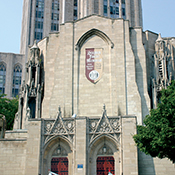Did You Know? ... Facts About Stephen Foster
If you’ve ever thought that the architecture of the Stephen Foster Memorial and Cathedral of Learning look remarkably similar—they are. Architect Charles Klauder designed both, building the Foster Memorial to complement the Cathedral of Learning.
While the Stephen Foster Memorial was conceived in the 1930s as a space for the performance of—and education about—Foster’s music, its use has evolved. It now contains two Pitt theaters: the Charity Randall Theatre and the Henry Heymann Theatre, as well as the Center for American Music, which is the repository for all materials pertaining to Foster.
the Stephen Foster Memorial was conceived in the 1930s as a space for the performance of—and education about—Foster’s music, its use has evolved. It now contains two Pitt theaters: the Charity Randall Theatre and the Henry Heymann Theatre, as well as the Center for American Music, which is the repository for all materials pertaining to Foster.
Foster (1826-1864) grew up in industrial Pittsburgh when it was attracting workers and families from many ethnic backgrounds. Influenced by German art songs, Irish melodies, Scottish ballads, Italian opera, and African American religious music, Foster created his own style, appealing to many groups and new immigrants who identified with the tunes as a way of sounding “American.”
Foster is the only American composer credited with writing two official state songs—“Old Folks at Home” for Florida and “My Old Kentucky Home” for Kentucky.
Foster’s “Hard Times Come No More,” his most recorded song, is used frequently as a concert encore by Bruce Springsteen.
Foster is considered by some to be the forefather of American popular culture, inspiring such diverse musicians as Al Jolson, Irving Berlin, Tommy Dorsey, and Ray Charles.
While Foster would be earning millions of dollars in royalties a year in today’s world, he died with 38 cents in his pocket. In his time, there was no music industry as such—and no safeguards protecting artists and their intellectual property.
Foster’s music continues to be popular in China and Japan, so much so that he and his wife, Jane, were the focus of a popular Japanese anime TV series in the 1990s.
—By Sharon S. Blake
Other Stories From This Issue
On the Freedom Road

Follow a group of Pitt students on the Returning to the Roots of Civil Rights bus tour, a nine-day, 2,300-mile journey crisscrossing five states.
Day 1: The Awakening
Day 2: Deep Impressions
Day 3: Music, Montgomery, and More
Day 4: Looking Back, Looking Forward
Day 5: Learning to Remember
Day 6: The Mountaintop
Day 7: Slavery and Beyond
Day 8: Lessons to Bring Home
Day 9: Final Lessons

